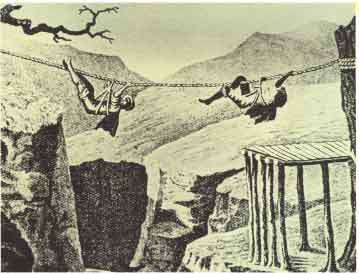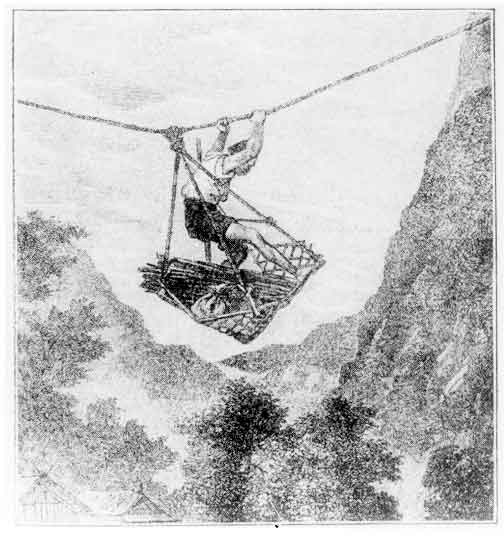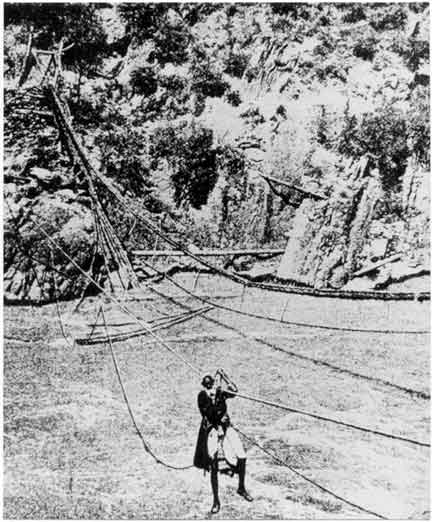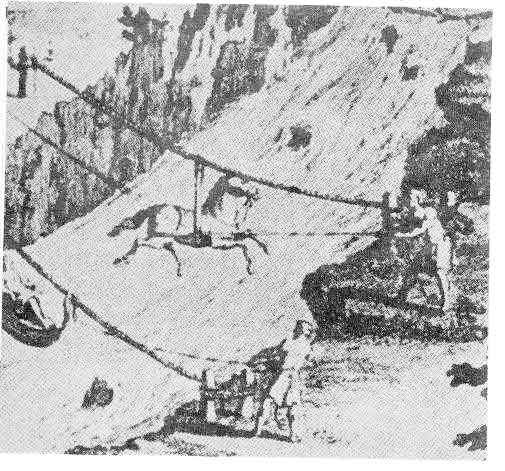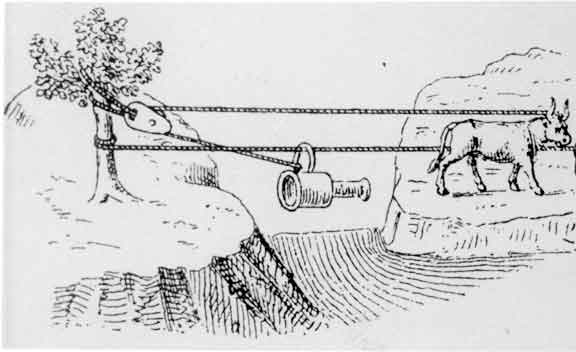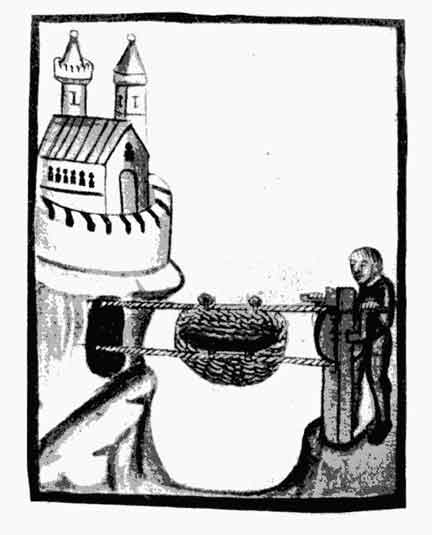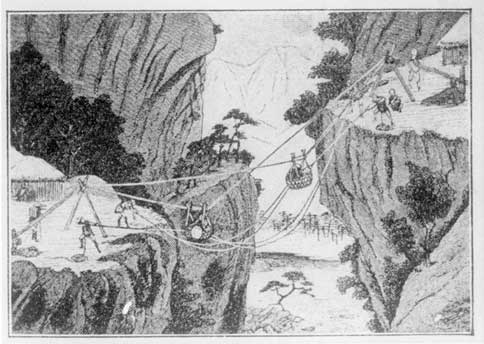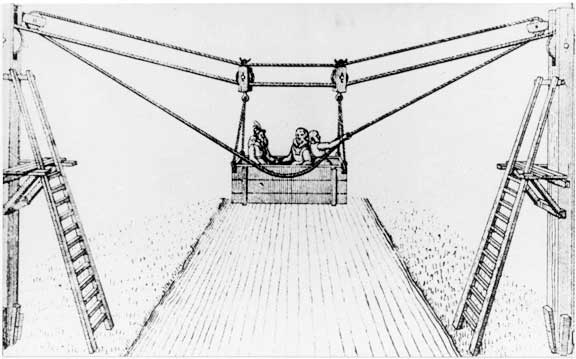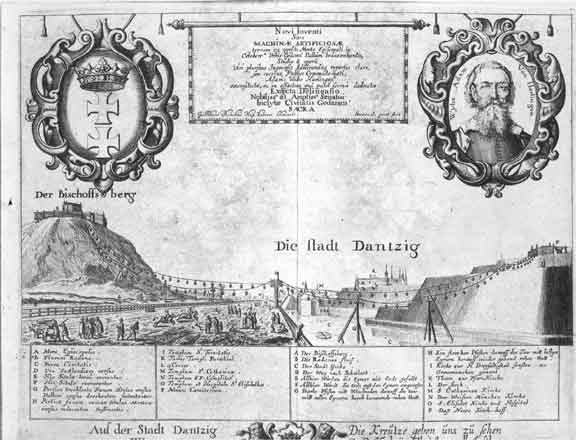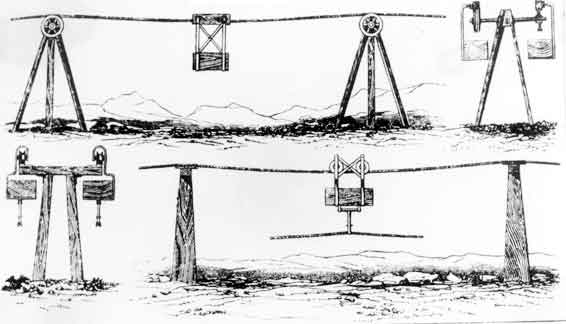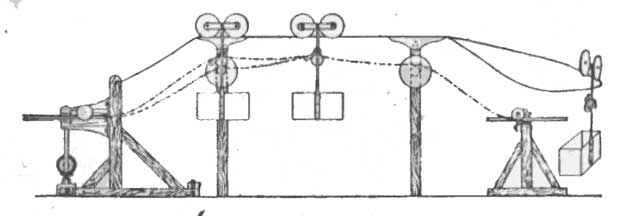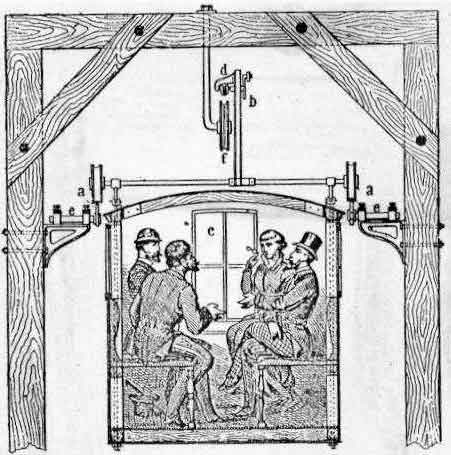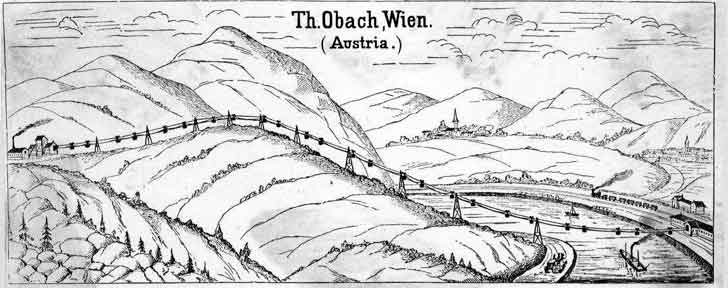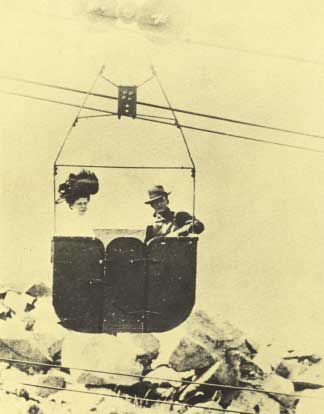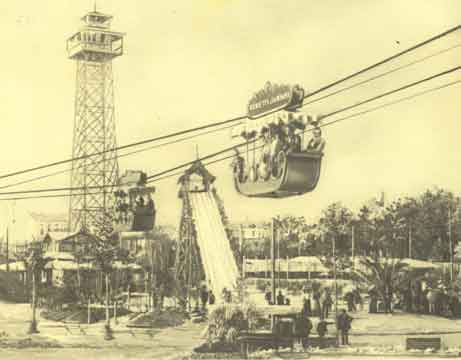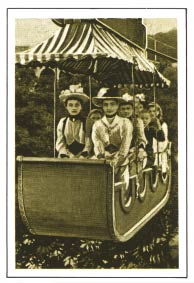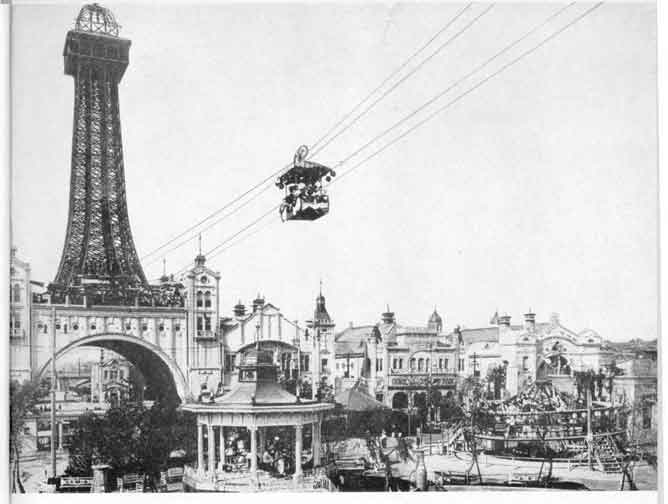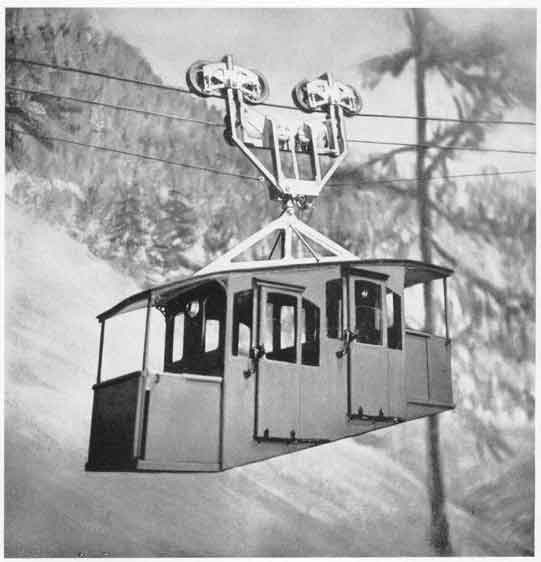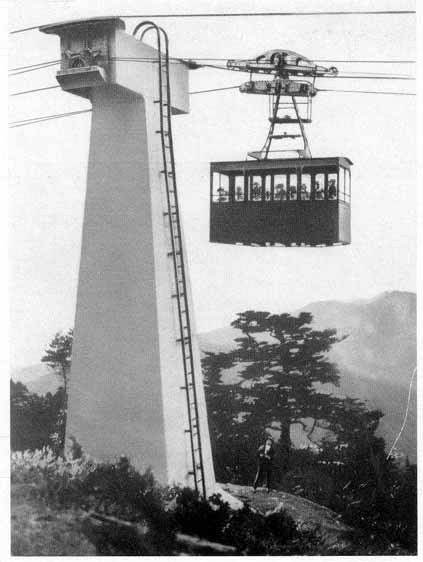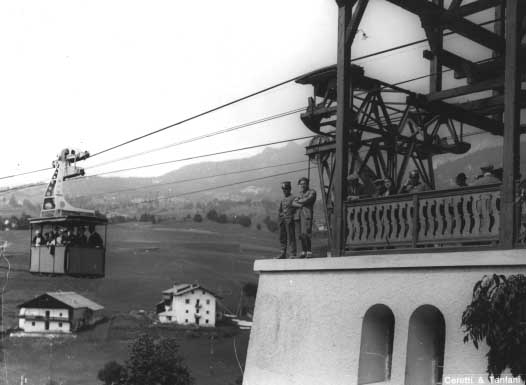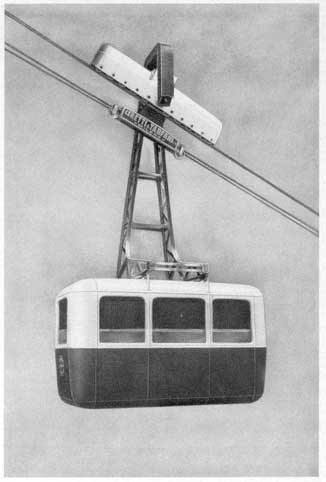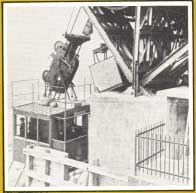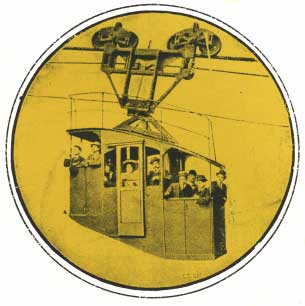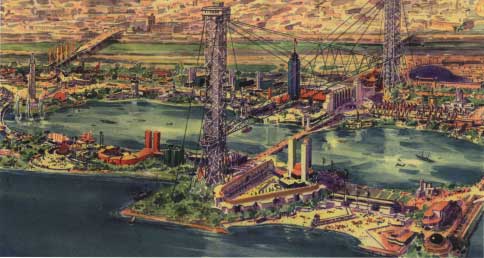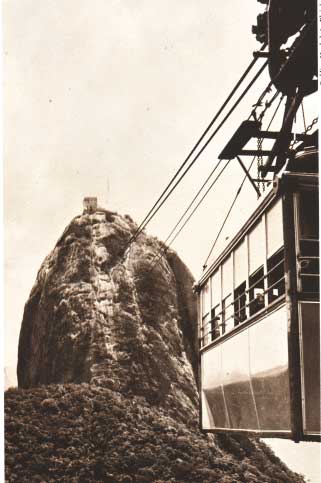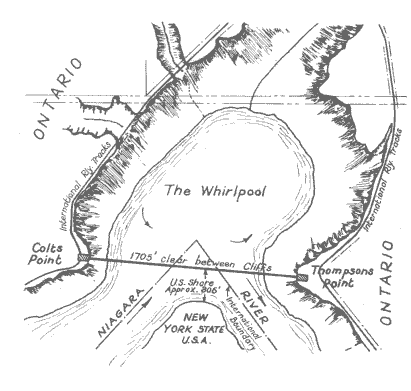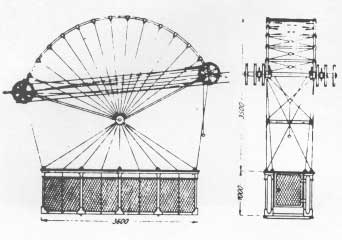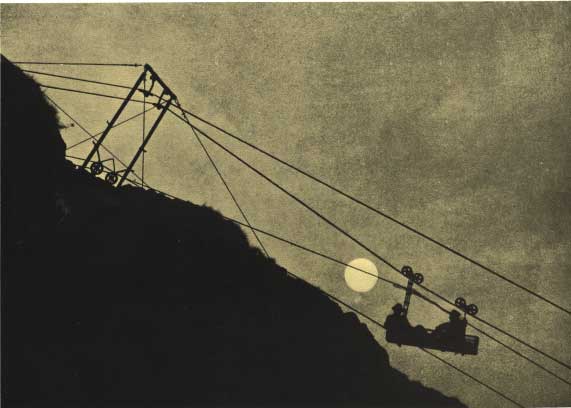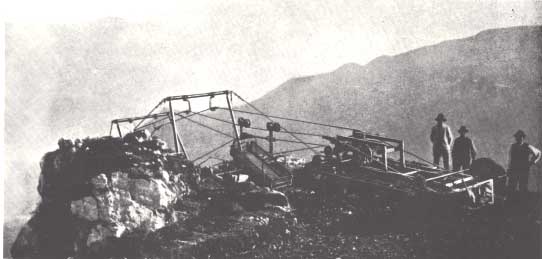|
(f-5b-17)
|
|
The first shadowy traces of ropeway history emanated from the
rugged Asiatic countries of China, India and Japan where steep
mountains cover 82% of the land. It was by intuition that men
imitated the activities of the apes and monkeys and considered
using a fiber rope to traverse the chasms blocking the intended
path. Suspension in a rude harness eased the load and allowed
a rest as the loop was slid along the rope track.
(Graphic Source: ELEVATOR WORLD, October 1967)
|
|
 |
(f-5b-2)
|
|
One of the first mentions of a ropeway is in the Japanese history,
"Taihetki." It relates how an Emperor of Japan escaped over a
precipitous valley about 650 years ago when surrounded by enemy
forces. The conveyance was a basket platform, allowing him to
carry a few possessions. The oriental historian called this rude
transfer mechanism the "Yaen" or "Wild Monkey" and even today
a simple Japanese ropeway for conveying timber carries this name.
(Graphic Source: ELEVATOR WORLD, October 1967)
|
|
 |
(f-5b-4)
|
|
When the rope bridge broke in India, the alternative was to haul
oneself along a primitive "track rope" strung across
the river.
(Graphic Source: Elevator World)
|
|
 |
(f-5b-5, f-5b-6)
|
|
Animals, a prime source of power, were conveyed across difficult
terrain although heavier tackle, pulleys and substantial braces
at the terminals would have been necessary to transport the horse
in the left graphic. In the right graphic, a beast of burden is
involved with the conveying process.
|
|
 |
(f-5B-3)
|
|
In this highly stylized medieval print, a man powers a windlass,
and one rope carries out the function of both a "haul" and "track"
rope. This a great deal of equipment to move such a small basket,
but it does signify how supplies and the occasional visitor were
lifted to monasteries built high on pinnacles to assure security
and meditation
|
|
 |
|
|
The next basic improvement in the ropeway system was the addition
of a "haul rope" to the basic "track rope." Another Japanese
wood cut indicates those on one side of a chasm using baskets
to convey personnel and material from one side to the other.
Although one load seems to have counterbalanced another, the
total pressure of the ropes and loads on the terminals would
have been considerable. Much thought must have been given to
adequate anchoring devices and the use of pulleys.
(Graphic Source: ELEVATOR WORLD, October 1967)
|
|
 |
|
|
In this graphic, the pulley is clearly evident in several locations.
The men crossing a river were probably being conveyed in a kind
of ferry, one man does the hauling and the others -- better
attired -- are enjoying the ride! Hopefully, the ladder does
more than afford a step up to the passenger box, for the stress
upon the two masts must have been considerable -- even with
wedges staked at the base!
(Graphic Source: ELEVATOR WORLD, October 196)
|
|
 |
|
|
Although a work by Venetian Fausto Veranzio in 1616 illustrates
a bi-cable passenger ropeway, the industry credits Dutchman
Wybe Adam with the first successful bi-cable operational system
in 1644. His constantly moving cars upon a hemp rope were used
to construct a hilltop fortress in Danzig.
(Graphic Source: ELEVATOR WORLD, October 1967)
|
|
 |
|
|
An important patent holder of the period was Charles Hodgson,
a British engineer. His sketches illustrate both mono- and bi-cable
types of ropeways. He is thought of, however, as the father of
the mono-cable which has importance down to our day -- one rope
supporting and hauling cars. These are shown conveying lumber,
but the affinity to the modern electric mono-rail passenger car
can be seen.
(Graphic Source: ELEVATOR WORLD, October 1967)
|
|
 |
(f-5b-14; f-5b-16)
|
|
The originator of the "standard coupling" in the
early 1870s was the Austrian von Obach whose sketches show the
essentials of the present-day circulating ropeway. All elements
are present except for the track and hauling rope tension weights.
Obach’s coupling allowed cars to be engaged and attached to
the trackway -- a major breakthrough that changed the nature
of ropeway systems, increasing their flexibility and popularity.
Obach, the only ropeway manufacturer in the Austro-Hungarian
Empire, later was purchased by Pohlig which later combined with
Adolf Bleichert, another Austrian pioneer.
(Graphic Source: ELEVATOR WORLD, October 1967)
|
|
 |
(f-5b-15)
|
|
In 1871, pioneer von Ducker installed a 500-meter-long system
in Germany, that descended under the action of gravity and was
returned by means of a winch and rope. Two years later, von
Ducker erected a continuously running system near Metz with
couplings between the car and the rope; however, the originator
of the all-important "standard coupling" was Obach,
an Austrian, who had obtained his patent the year before. His
sketches are remarkable in that all the essentials of the present-day
circulating ropeway are present, except the tension weights
for the track and hauling ropes. Obach's coupling, which allowed
cars to be dis-engaged and reattached to the trackway, was a
major breakthrough and radically changed the nature of the ropeway
systems, increasing their flexibility and popularity. The firm
of Obach, the only ropeway manufacturer in the then Austro-Hungarian
Empire, was purhcased by J. Pohlig upon the inventor's death
in 1887. Today, the Pohlig firm continues in business, having
combined with the company founded by the earliest of the German
pinoeers, Adolf Bleichert.
|
|
 |
|
|
In far-off Knoxville, Tennessee, a bi-cable circulating system
with a two-passenger bucket made news in 1893. However, government
officials on both sides of the ocean were skeptical of sky-rider
safety until major breakthroughs the following year at the Exhibition
of Milan.
(Graphic Source: ELEVATOR WORLD, October 1967)
|
|
 |
(f-5b-20)
|
|
The Milan Exhibition of 1894 brought this newspaper comment,
“Ceretti & Tanfani’s novelty aerial ride has delighted the visiting
public. Elegant open cars, forming a strange cross between a
boat and a basket, suspended by metal ropes many meters above
the ground, run non-stop in either direction over a course of
considerable length. There is no danger, no jolting, only the
pleasant sensation of cleaving the air, floating between earth
and sky, watching from above the swarm of visitors in the gardens
below."
(Graphic Source: ELEVATOR WORLD, October 1967)
|
|
 |
(f-5a-4; f-5b-21)
|
|
Following the successful experiment in Milan, Ceretti & Tanfani
built a number of circulating passenger ropeways at expositions
throughout the world, including 1896 at Geneva; Buenos Aires and
Rio de Janeiro in 1896; across the River Po at Turin in 1898 and
at Vienna and Osaka in 1912. The installation in Japan is illustrated.
(Graphic Source: ELEVATOR WORLD, October 1967)
|
|
 |
(f-5a-5, f-5a-2, f-5b, f-5a-1)
|
| Installations by
Ceretti & Tanfani in 1926 in Cortina, 1928 in Kyoto and 1929
in Barcelona indicate the evolution in cabin design.
(Graphic Source: Ceretti & Tanfani)
|
|
 |
|
|
At the beginig of the 20th Century, the “jig-back:, circulating,
“to and fro” or reciprocating passenger ropeways were becoming
common place. In 1908, Von Roll’s “Wetterhorn” system in Grindlewald,
Switzerland, featured fully locked track rope, tensioned by
a counterweight, DC motor drive, gasoline auxiliary engine and
safety brakes on the car hanger. The passengers moved to a 1,380-foot
height at a speed of 150 feet per minute.
(Graphic Source: ELEVATOR WORLD, October 1967)
|
|
 |
|
|
Whereas the Von Roll installation operated between only two
trestles, Ceretti & Tanfani’s Merano, Italy installation in
1912 incorporated the use of 39 trestles, establishing the kind
of system that would allow transport over highly irregular mountainside
profiles. The capacity was 16 persons traveling at 250 fpm.
(Graphic Source: ELEVATOR WORLD, October 1967)
|
|
 |
(f-5b-30)
|
|
The promoters of the Century of Progress Exposition of 1933 in
Chicago had planned to erect a tower to exceed the Eiffel Tower
as a centerpiece. However, the economic Depression made such expenditure
impossible. The substitute was an elevated aerial ropeway or "tramway"
system operating between two 628-foot towers, 2,000 feet apart.
Streamlined gondolas - rocket cars carried passengers across the
Chicago River at a height of 210 feet. No doubt at least one elevator
operated in each stanchion, taking viewers to what appears to
be a viewing platform on atop each.
The New York World's Fair of 1939-1940 was noted for political
ramifications rather than transit. The flags at the French and
Polish Pavilions were flown at half-mast; the Japanese Pavilion,
mean to have permanence, was destroyed. The Soviet Union Pavilion,
popular in 1939, was demolished in 1940 when Hitler and Stalin
signed their non-aggression pact.
The Gallery solicits information concerning these elevators.
(Graphic Source: World's Fair)
|
|
 |
|
|
The German firm of Pohlig contributed a spectacular gondola
system at the harbor of Rio de Janeiro in 1912, far from the
usual habitat of such ropeways in the snowy peaks of Central
Europe. The system, completed in two stages to the top of Pao
de Acucar (Sugar Loaf Mountain), involved no trestles. The first
span covered a distance of 631 yards while the leg to the top
was a length of 878 yards.
(Graphic Source: ELEVATOR WORLD, October 1967)
|
|
 |
(f-5b-28, f-5b-27, f-5b-29)
|
|
The cableway installed across the famed Niagara Falls Whirlpool
had an international flavor being built in Spain to connect Canada
with the U.S. Designed by Torres y Quevado, a noted aeronautical
engineer, the system spans 1,800 feet and clears the rapids by
150 feet. The huge steel lacework car has a capacity of 24 seated
passengers, 24 standees and a conductor. The car weighs seven
tons when fully loaded and was tested at three times that capacity
before becoming operational. (Graphic Source: ELEVATOR WORLD,
October 1967)
|
|
 |
(f-5b-25; f-5b-26)
|
|
When World War I exploded in Central Europe, Italy and Austria
found themselves in separate camps. Both country’s Alpinist troops
sought to dominate the ridges of the Dolomites that formed a natural
boundary between them. The years from 1914 to 1918 saw history’s
most ferocious mountain warfare fought in this region’s high altitudes
where the front became as stalemated as that between France and
Germany. Almost 2,200 ropeways were operated by the Italians and
over 400 by the Austrians, almost all of which were portable.
Initially, the aerial transport carried timber and other material
for bunkers, along with howitzers and ammunition. Later, stretcher
carriers lowered casualties to hospitals much as helicopters of
our day carry stretchers outboard from the front to first aid
stations in the rear.
(Graphic Source: ELEVATOR WORLD, October 1967)
|
|
 |





















